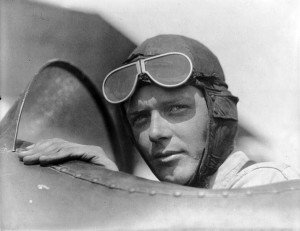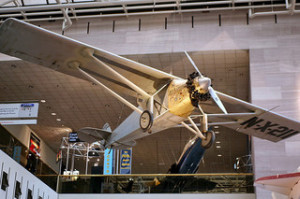 In 2013 the average flight time between New York and Paris is 7 hours and 30 minutes with 3635 miles separating the cities. In 1927 Charles Lindbergh did it in 33 hours, 30 minutes and 29.8 seconds to become the first human to fly the Atlantic Oceaen. He left on May 20 from Roosevelt Field, Long Island, New York at 7:52 am (EST) and arrived in Le Bourget Aerodrome, Paris, France on May 21 at 5:22 pm (EST). He hadn’t slept for a total of 55 hours and landed to cheers that echoed across the world.
In 2013 the average flight time between New York and Paris is 7 hours and 30 minutes with 3635 miles separating the cities. In 1927 Charles Lindbergh did it in 33 hours, 30 minutes and 29.8 seconds to become the first human to fly the Atlantic Oceaen. He left on May 20 from Roosevelt Field, Long Island, New York at 7:52 am (EST) and arrived in Le Bourget Aerodrome, Paris, France on May 21 at 5:22 pm (EST). He hadn’t slept for a total of 55 hours and landed to cheers that echoed across the world.
Charles Lindbergh was characterized as being shy and studious. Certainly not characteristics you’d normally associate with fearless and world changing. But he would be the first in the history of the world to fly the Atlantic. In the Army we used to say that those who talked a big game in training were normally the first to hide or run in battle. Charles Lindbergh didn’t talk a big game but with the Spirit of St Louis he proved his metal.
With this historic achievement Charles Lindbergh changed the future of aviation. His involvement started with planes that used wires and wood all the way to consulting for supersonic jets. At the age of 25 he changed how each of us travels with a fearless attitude when he accepted the $25,000 challenge put forth in 1919 by a businessman. More experienced pilots before him had tried and failed; with some even dying. It became known as the Orteig Prize and Charles Lindbergh claimed it. He was given nicknames like Slim, Lucky Lindy and my favorite The Lone Eagle. San Diego’s International Airport is called – Lindbergh Field. He’d eventually go on to fly 50 combat missions in April, 1944 over the Pacific and become appointed a Brigadier General by President Eisenhower in 1954.
The Lone Eagle is Fearless Charles Lindbergh
You ever wonder what he had to face in that small plane over the icy, cold, lonely Atlantic Ocean? If you’re curious to know the details, in his book “The Spirit of St Louis” he details his journey from preparation for this historic flight to landing in Paris. The New York Times book review by Quentin Reynolds on September 13, 1953 said, “At last we have a book that explains and humanizes Lindbergh; that bring him into the company of his fellow mortals. The book is The Spirit of St. Louis, and it is of course written by the one man who really knows Lindbergh – Himself.” It’s interesting that he used the words “humanizes” and “mortals”.
Charles Lindbergh didn’t do it for money. Out of the $25k prize money he actually only got less than $10k of it because he had to take out a $15k business loan and his savings to build The Spirit of St Louis. There was more to it for him to do this daring feat. It seems it was his passion and love for aviation, exploring and inventing. This gave him the courage to go through with it. This reminds me of other men who changed history. Remember Apollo 11 and Neil Armstrong landing on the moon 20 July, 1969? Or more recently Fearless Felix Baumgartner who set the record for skydiving last year (2012)? These men all shared something in common – a vision and goal with the fortitude to see it through. 
During those 33 hours, 30 minutes and 29.8 seconds Charles Lindbergh experienced trauma that we might sometimes characterize as “torture”. He went a total of 55 hours without sleep. During his flight he started to hallucinate because of exhaustion. He got so cold that he closed the windows, only to have to open them because he needed the fresh air to help stay awake. For half the flight he flew over a dark ocean of blackness without a single soul in sight. You know what you do in darkness? You go back to the light. Not an option for him. He had no phone or way of communication. It was reach land on the other side or sink into the dark black abyss below. No matter how much he planned, which I’m sure he and others did, there is no way to predict every danger. Especially those that challenge your emotions and fears. The only comfort he had was to strive on ahead. Which he did and after 25 hours of flight he passed an Irish fishing boat and he knew he was close to his destination. The rest is history!
Strength and courage may not be built overnight, but some of the greatest heroic moments are decided in a split second. A man is faced with a challenge and he Mans Up.
1st Photo by http://www.flickr.com/photos/sakraft1/
2nd Photo by http://www.flickr.com/photos/nostri-imago/
Often times, the cost of competing for a prize costs more than the prize itself. Over $100 million was spent between contenders for the $10 million Ansari X Prize, which was modeled after the Orteg Prize and for the same reason: to spur commercial growth of a budding industry.
You’re right! With many events the cost for trainng and materials exceed the prize money. I’ve never heard of the Ansari X Prize. I’ll have to Google that.
Great profile. I couldn’t imagine being awake for 55 hours. I can’t imagine the excitement people felt when that plane landed. I was WAY fired up watching Felix jump earlier this year. Great for the human spirit to see that kind of stuff.
Me neither! Even in the Army I think my longest time awake was around 48 hours. And I wasn’t flying a plane and had some naps interspersed through out.
Thanks for sharing, a very inspiring story. I had never heard of Charles Lindbergh before today.
No way! I incorrectly assumed everyone had heard of him. But maybe my parents just liked Jimmy Stewart too much so I got to see him play Lindbergh in the movie – The Spirit of St Louis.